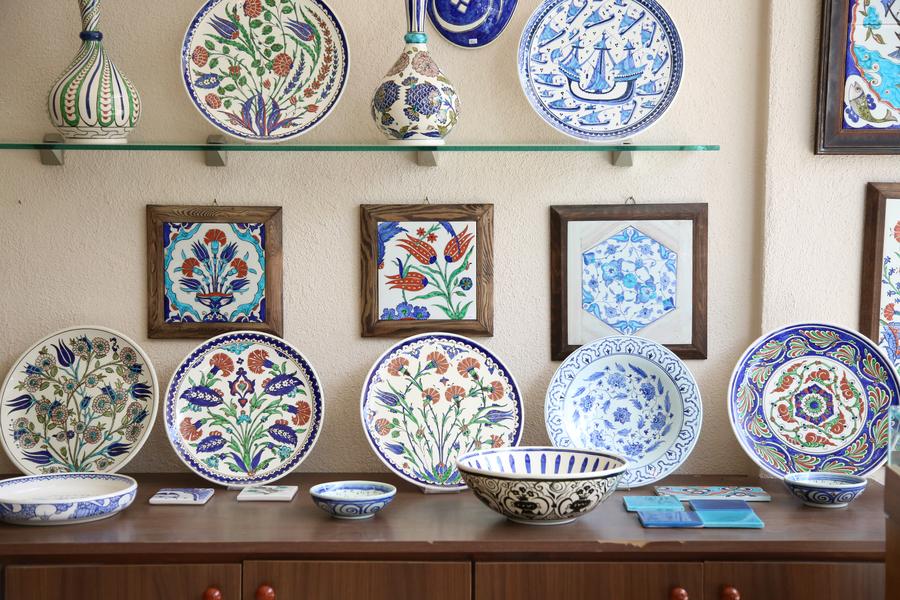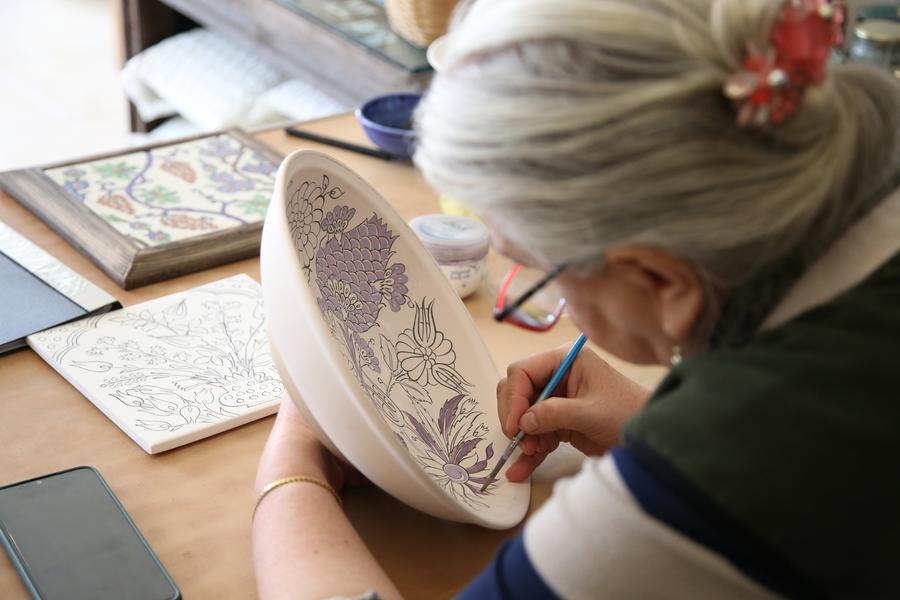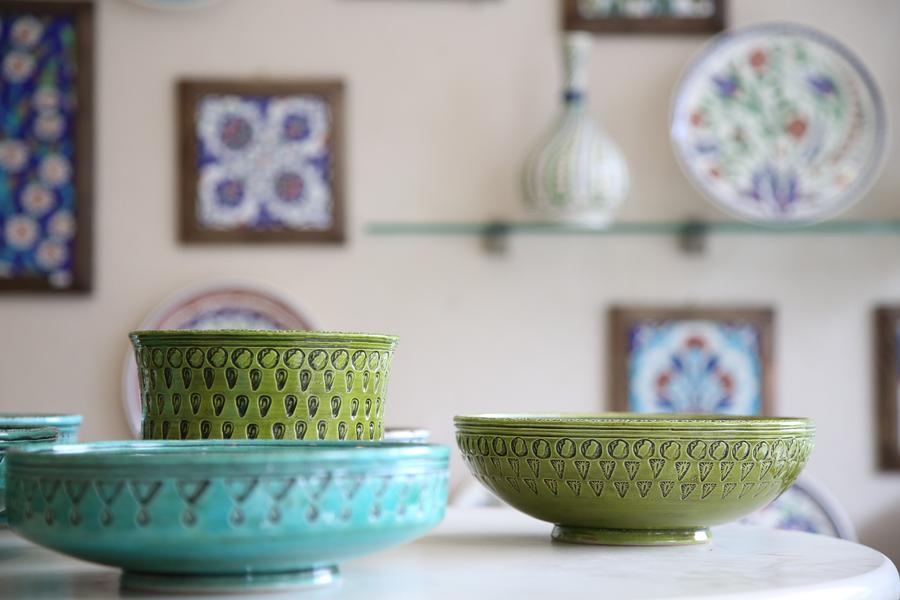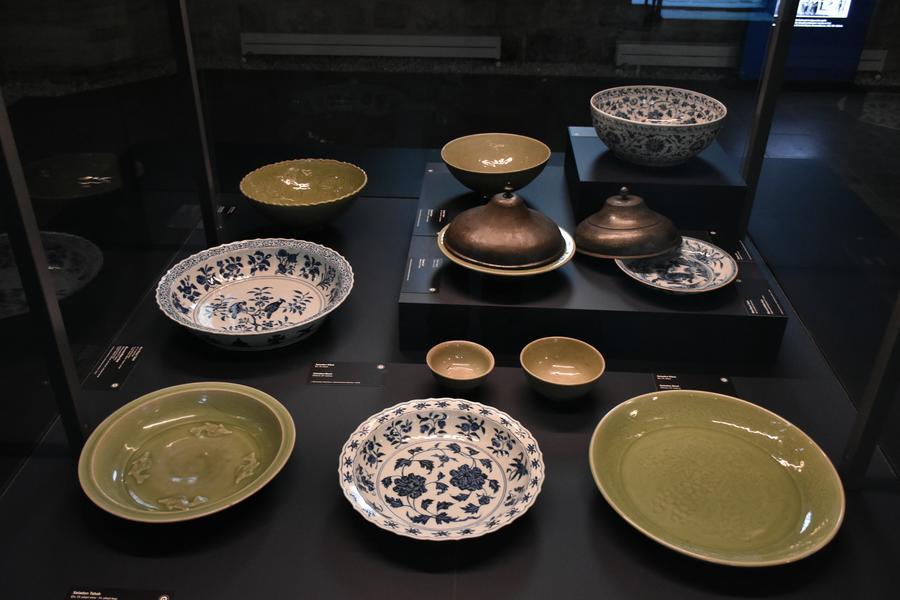Porcelain wares are displayed in Iznik, Türkiye, on May 17, 2024. (Xinhua/Li Zhenbei)
by Burak Akinci
IZNIK, Türkiye, May 21 (Xinhua) -- China's Jingdezhen and Türkiye's Iznik cities stand as a testament to shared cultural values between two ancient cities and their passion for fine porcelain making, Turkish ceramic experts said.
"There are many similarities between Chinese porcelain and Iznik ceramics," Adil Can Guven, a famous Turkish ceramic artist told Xinhua in a recent interview.
He was referring to the northwestern Turkish city of Iznik which was the main center of ceramic production under the Ottomans.
Iznik, a district in the Bursa province of modern Türkiye, boasts a rich history spanning 2,000 years, dating back to its time as the Byzantine city of Nicaea.
A woman draws on a porcelain ware in Iznik, Türkiye, on May 17, 2024. (Xinhua/Li Zhenbei)
During the Ottoman era, influenced by Chinese craftsmanship, Iznik's ceramics and porcelain industry experienced rapid growth from the 15th to the 17th centuries, reaching its zenith in the 16th century.
Guven, a 70-year-old ceramist who recently visited Jingdezhen, the world-famous "porcelain capital" in east China's Jiangxi Province, said he was "very impressed" by the city and its history of porcelain-making dating back over 2,000 years.
Jingdezhen's past role as an official and imperial kiln has elevated the art of porcelain making to unprecedented heights.
"We were very impressed by the porcelain produced in Jingdezhen," he pointed out, stressing that the design of some pieces showcased in the local museum is still in use in Iznik ceramics, such as grapes and waves.
"The Ottomans were significantly inspired" in their ceramic art by the renowned Chinese blue-and-white porcelain, this artist stressed.
The porcelain produced in Jingdezhen and then exported to the Islamic world through the ancient Silk Road bears now testimony to the city's shared values with modern-day Türkiye and its love for ceramics, according to Guven.
In the 15th century, Chinese porcelain gifted to the Ottoman Empire had a very significant importance on Anatolia and the Ottoman Palace, this artist said.
Jingdezhen porcelains inspired Turkish tile masters since the Ottoman era and paved the way for the start of porcelain production in Türkiye, Mehmet Aras, a scholar and expert on ceramics, said to Xinhua in Iznik.
"The Chinese were the first to produce porcelain in the world. It was first made by Chinese craftsman until the 17th century when many other communities tried to emulate their technique," he said.
Porcelain wares are displayed in Iznik, Türkiye, on May 17, 2024. (Xinhua/Li Zhenbei)
Technically, porcelain is a type of ceramic, but porcelain is made with superior-grade clay and needs to be fired at more extreme temperatures than ceramics. Porcelain is therefore harder, he noted.
The word "cini" synonymous with ceramics and pottery in Turkish can be translated roughly as something related to China, Aras explained, highlighting that Turkish ceramics are a reflection of Chinese porcelain.
Porcelain, as a symbol of traditional Chinese culture, has built a bridge of cultural exchange between ancient China and foreign countries.
In the present day, Türkiye's "capital of ceramics" Iznik and China's "capital of porcelain" Jingdezhen are sister cities and mutual exchanges of artists and local officials are very important, Iznik's deputy mayor Ahmet Kaya, told Xinhua.
Jingdezhen and Iznik are two ancient cities that share many commonalities, including culture and civilization. "We have succeeded in building a bridge of friendship and brotherhood," he stated.
Aras and Kaya participated in the 2023 China Jingdezhen International Ceramic Expo in October.
"I was very impressed with what I saw in Jingdezhen, and how the local history has been kept alive," this official stressed.
"Iznik ceramics have been inspired by Chinese porcelain, and the origin of this inspiration is Jingdezhen," the deputy mayor added.
Meanwhile, Topkapi Palace Museum in Türkiye's Istanbul, once the residence of the Ottoman sultans, has been displaying since early May additional pieces from its extensive collection of Chinese porcelain following a major makeover.
This photo taken on April 29, 2024 shows some exhibits during an exhibition of Chinese porcelain at the Topkapi Palace Museum in Istanbul, Türkiye. (Photo by Safar Rajabov/Xinhua)
After a three-year restoration, visitors can admire thousands of Chinese porcelain pieces, including those exclusively crafted for the sultans, drawing significant attention from Turks and foreign tourists alike.








 A single purchase
A single purchase









